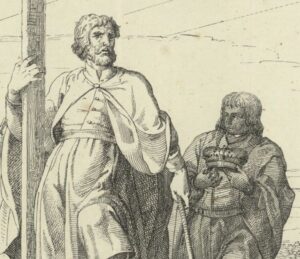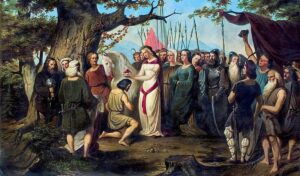The marriage of Mieszko I and Dobrawa was neither a romantic impulse nor a haphazard decision. It was a carefully orchestrated alliance designed to help one of the weakest players in Central Europe survive. For the Piast ruler, it was a step into Europe’s political elite. For the Přemyslid dynasty, a calculated move to secure their regional influence. But what was the real reason behind this union? Politics, religion – or perhaps even the slave trade?
Polish-Czech Negotiations
Negotiations between Poland and Bohemia regarding Mieszko I’s marriage to Dobrawa must have begun by late 964 at the latest, since the wedding took place in 965. Scholars believe that Mieszko’s official delegation to Prague, sent to request the hand of Duke Bolesław the Cruel’s daughter, was led by a trusted associate – possibly a close relative or even his brother. Some historians suggest that Mieszko himself may have travelled to the Czech capital, a gesture that would have demonstrated just how much he valued the alliance with the Přemyslid house. A later medieval source even claims the wedding ceremony took place in Prague, likely a faint echo of this important journey.
It is unknown how long the marriage negotiations lasted. It is entirely possible that the two dynasties reached an agreement after only one meeting. Bolesław had a daughter of marriageable age – a clear advantage when bargaining with his northern neighbor.
Once the Polish-Czech talks ended in success, Mieszko I likely began preparing for a wedding unlike anything seen before in his young state. It is assumed that he personally welcomed his future bride at the border separating Greater Poland and Silesia.

Jan Długosz, writing centuries later, vividly described Dobrawa’s arrival in Poland. In his account: “The virgin Dąbrówka was accompanied by many Czech nobles and knights, alongside Mieszko’s envoys, in great splendor and at great expense. She brought with her a rare and impressive dowry, worthy of both her father-in-law and her future husband. Duke Mieszko came to meet her with his Polish barons and dignitaries, and all ranks of society welcomed her with honor and solemnity. To celebrate her arrival, the most distinguished Polish matrons and maidens, adorned with jewels, gold, silver, and other ornaments, gathered in Gniezno at the duke’s command”.
An Unforgettable Wedding
For his wedding, Mieszko would have invited many prominent guests – tribal elders, military commanders, close advisors, and relatives. Invitations were also extended to Dobrawa’s family and the Czech elite. The total number of attendees remains unknown.
At the time, wedding festivities typically lasted several days after the formal exchange of vows. This was likely the case for Mieszko and Dobrawa. Guests were treated to the finest food and drink, and their free time was filled with various entertainments. According to experts, the entire celebration took place in Gniezno, then the political center of the Piast realm.
Scholars believe that after the wedding, Mieszko temporarily settled Dobrawa at the stronghold on Ostrów Lednicki, ensuring her safety in a country still entirely pagan. Gniezno, being the principal site of pagan worship among the Piasts, would not have been a welcoming environment for the Christian princess and her ecclesiastical entourage.
Archaeologists have discovered an entire palatial-sacral complex on Ostrów Lednicki, built before Dobrawa’s arrival. The bridges leading to the island and the impressive buildings found there suggest that high-ranking individuals had been visiting from the outset. Evidence of Christian religious practice has also been uncovered – including a liturgical knife, an ornate liturgical comb, a bronze cross, a fragment of a prince’s bronze clasp, and a chest containing ritual tools.

Slavery and Mieszko’s Marriage?
Mieszko I’s marriage to Dobrawa was a typical dynastic union, cementing a short-term alliance between Poland and Bohemia. Within this pact, the Piast ruler was politically far weaker than the Přemyslids, who had long been part of the established Christian political order. By contrast, the Piasts were just entering the regional geopolitical stage – with much to learn.
There must have been compelling reasons for both sides to agree to the alliance. Otherwise, a Christian duke from the Vltava would hardly have allowed his daughter to marry a pagan who had only just begun his rule. Unfortunately, the historical sources do not reveal what those reasons were. Historians have considered both political and economic motivations. It is likely that both played a role, but determining which prevailed remains impossible based on current research.

Some scholars argue that Mieszko entered the alliance primarily for economic gain, especially to expand the slave trade. Prague was then the largest slave market in Europe, and Slavic captives were regularly exported from there to Arab lands. It may not be a coincidence that over half a million Arab dirhams – the currency used by Muslims to pay for such human cargo – have been found in Greater Poland. These coins likely paid for people captured by Mieszko during inter-tribal conflicts in what would become Poland.
See also: Marriage of Necessity? Leszek the White and the Ruthenian Princess
From Bohemia’s perspective, ensuring a steady influx of slaves from the north was crucial. Some sources even claim that the Czechs sold Christians to Muslim buyers. They feared that Piast expansion toward the Baltic could divert the slave trade away from Prague and toward northern ports. Thus, the two sides reached an agreement, with the Poles promising not to act against Bohemian interests. Ironically, the deal also benefited Mieszko, giving him unrestricted access to Prague’s lucrative slave market.

Poland – Bohemia – Germany
According to most historians, Mieszko I sought not to profit but to break the Bohemian–Veleti alliance, which had proved dangerous after the Piasts suffered defeats on their western frontier. While written sources do not confirm that the Czechs supported the pagan Veleti during the war around 963, their military neutrality still posed a risk – Mieszko could not predict how they might act in future conflicts.
Historians emphasize that Mieszko had few options. Geographical and ethnic proximity made alignment with Bohemia a logical step. Judging by subsequent events, he eagerly seized the opportunity to dismantle the Czech-Veleti alliance. Had he failed, Polish history could have taken a very different path – one in which parts of the Piast realm might have been permanently lost to stronger neighbors or even ceased to exist altogether. Mieszko’s strategic acumen averted the worst-case scenario.

Some scholars argue, however, that the Veleti factor played little or no role in the 965 agreement. Instead, they point to Germany. Both the Piasts and Přemyslids had reason to seek a counterweight to the growing imperial power of the Ottonians. Mieszko’s priority was avoiding the fate of the Bohemians, who had become nearly dependent on the Germans and were obliged to provide military support whenever the emperor demanded. Mieszko may have feared the expansionist march of Gero, the margrave of the Eastern March, who extended imperial control east of the Oder. Gero’s death in 965, which led to the division of his massive territory, likely encouraged Mieszko to act more decisively in the south. It was a moment ripe for strengthening his position in the Slavic world.
Meanwhile, the Přemyslids’ motivation to align with the Piasts was less about breaking free from the Ottonians than responding to German policy in the Elbe region. Throughout the 950s and 960s, German military campaigns had dramatically expanded the already powerful Eastern March. The prior subjugation of the Wkrzans and Stodorans had left the Bohemians without northern allies – allies that might once have helped resist growing imperial pressure.
See also: What Was Duchess Dobrawa’s Husband Really Called?

Short-Term Consequences of the Alliance
It is difficult to determine whether Poland or Bohemia gained more from the alliance. But it is clear that Mieszko’s alignment with the Czech court marked a true breakthrough for the Piasts. Until then, the ruler of Greater Poland had been largely unknown and his land viewed as barbaric. Now he emerged as a significant Slavic power in the region.
Because Bohemia was, at the time, one of the most powerful states in Central Europe (second only to the Empire), Mieszko could count on support from the famed Czech heavy cavalry – known for its excellent equipment and training. Thanks to contacts with Germany, Hungary, and Great Moravia, the Czech cavalry had a rich martial tradition. By allying with his southern neighbors, Mieszko boosted his military potential – something he might well need in future clashes with the Veleti or even the Germans themselves.
Bibliography:
-Barkowski R. F., Mieszko I i Dobrawa, czyli sojusz Polski z Czechami, „Mówią Wieki” 4 (2016).
-Besala J., Małżeństwa królewskie, Piastowie, Przemyślidzi, Andegawenowie, Warszawa 2006.
-Czwojdrak B., Dobrawa (ok. 930-977), [w:] Poczet władczyń Polski, red. B. Czwojdrak, Kraków 2017.
-Labuda G., Księżna Dobrawa i książę Mieszko jako rodzice chrzestni Polski piastowskiej, [w:] Scriptura custos memoriae, Prace historyczne, red. D. Zydorek, Poznań 2001.
-Labuda G., Mieszko I, Wrocław 2009.
-Labuda G., Polska, Czechy, Niemcy i Związek Wielecki w X wieku, [w:] idem, Fragmenty dziejów Słowiańszczyzny zachodniej, t. 1, Poznań 2002.
-Maleczyński K., Polska a Czechy w latach 966-986, [w:] Studia z dziejów polskich i czechosłowackich, t. 1, red. E. i K. Maleczyńscy, Wrocław 1960.
-Maleczyński K., Polska a Czechy w średniowieczu, Próba rewizji pojęć, „Śląski Kwartalnik Historyczny Sobótka” 2 (1947).
-Matla M., Czechy, Poznań 2014.
-Nový R., Czechy, Polska i Europa Środkowa w X wieku, [w:] Civitas Schinesghe, Mieszko I i początki państwa polskiego, red. J. M. Piskorski, Poznań-Gniezno 2004.
-Paner A., Przemyślidzi, Od Borzywoja I do Przemysła II Otokara, Ludzie i wydarzenia w latach 872-1278, Gdańsk 2008.
-Strzelczyk J., Mieszko I – pierwszy historyczny władca Polski, [w:] Ojczyzna wielka i mała, Księga pamiątkowa wydana z okazji 40-lecia Oddziału Polskiego Towarzystwa Historycznego w Cieszynie, red. I. Panic, Cieszyn 1996.
-Strzelczyk J., Mieszko I w opiniach współczesnych i potomnych, [w:] Civitas Schinesghe, Mieszko I i początki państwa polskiego, red. J. M. Piskorski, Poznań-Gniezno 2004.
-Strzelczyk J., Mieszko I w świetle niektórych nowszych badań, [w:] Cedynia i okolice poprzez wieki, red. P. Migdalski, Chojna-Szczecin 2013.
-Strzelczyk J., Państwo Przemyślidów w Europie zachodniosłowiańskiej, [w:] Wielkopolska – Polska – Czechy, Studia z dziejów średniowiecza ofiarowane profesorowi Bronisławowi Nowackiemu, red. Z. Górczak, J. Jaskulski, Poznań 2009.
-Wojciechowski Z., Polska-Czechy, Dziesięć wieków sąsiedztwa, Katowice-Wrocław 1947.
Author: Gabriela Zapolska